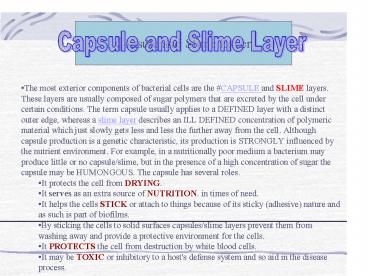Capsule and Slime Layer - PowerPoint PPT Presentation
1 / 21
Title:
Capsule and Slime Layer
Description:
short, rigid protein rods, similar in size to flagella, but not involved in motility. ... 2- Discoverer Brucella abortus. 3- Disease - Vibrio cholera. ... – PowerPoint PPT presentation
Number of Views:930
Avg rating:3.0/5.0
Title: Capsule and Slime Layer
1
Capsule and Slime Layer
2
- Flagella
- curved filament made of flagellin protein
travels through hollow tube, assembles at
external end.
- polar flagellation flagella attached at one
(monopolar) or both (bipolar) ends. Ex
Pseudomonas aeruginosa - peritrichous flagellation flagella attached at
many sites around cell periphery. Ex E. coli
3
(No Transcript)
4
(No Transcript)
5
Electron micrograph of pili
Electron micrograph of pili
- fimbriae pili
- short, rigid protein rods, similar in size to
flagella, but not involved in motility. - function in adhesion, formation of pellicles at
liquid surfaces. Function not entirely clear.
Pili sometimes involved in pathogenic adhesion
(e.g. gonorrhea) - Sex pili in conjugation.
6
Endospores Produced by gram positive
bacteria(Bacillus, Closteridia,
Sporosarcinia) and Coxiella bunetii. Sporulation O
ccurs at the end of the log phase Germination -
Activation - Initiation Outgrowth. Properties 1
- Core 2- Spore wall 3-Cortex 4- Coat 5-
Exosporium
7
(No Transcript)
8
Endospore Pi cures
Endospore Pi cures
Centrally (left),
terminally (center), and subterminally (right)
located endospores. Pictures from Brock Biology
of Microorganisms (lecture textbook)
9
SPORE FORMING BACTERIA
Spores from woodland
pond. Image taken using a phase contrast
Some G bacteria form resistant structures called
SPORES under adverse conditions. Spores are the
most RESISTANT life form known. They are able to
survive boiling in water at 100oC for long
periods. Spores are resistant to UV-light, to
drying and many harmful chemicals. We know spores
can live for 100s of yr. and recently spores
several million yr. old have been revived from
insects trapped in amber. Some disease organisms
like anthrax and botulism form spores that reside
in the soil. The size, shape, and location of a
spore in the cell are all identifying genetic
characteristics.
10
Bacteria reproduce by binary fission in which one
bacterial cell divides into two cells. Following
elongation of the cell, a transverse cell
membrane is formed and, subsequently, a new cell
wall. The new transverse membrane and wall grow
inward from the outer layers, a process in which
the septal mesosomes are intimately involved. The
nucleoid, which have doubled in number preceding
the division, are distributed equally to the two
daughter cells.
Cell Division
11
Bacterial Cell Components
12
Size, and Morphology of Bacteria Size 1 u. Some
bacteria such as Chlamydia and Rickettsia are
o.25 u in size. Morphology and Arrangement -
Cocci clusters, diploes, chains, tetrads. -
Bacilli - Spiral - Filamentous - Coccobacilli
13
(No Transcript)
14
Bacterial arrangement and Morphology
15
Staining
Dye Properties Dyes used to stain bacterial
cells are organic compounds, which have affinity
for specific cellular components. The many types
of dyes have two features in common 1) they have
chromophore groups, groups with conjugated double
bonds that give the dye its color and 2) they can
bind with cells by ionic, covalent, or
hydrophobic bonding. Dyes also contain an
auxochrome group, which in itself does not
produce color but gives the dye its acidic or
basic properties. Since the surfaces of
bacterial cells are negatively charged such as
nucleic acids and acidic polysaccharides, basic
dyes are most often used in bacteriology. Acidic
dyes, because of their negative charge, bind to
positively charged cell structures such as
proteins. Commonly used basic dyes are methylene
blue, crystal violet, safranin, basic fuchsin,
and malachite green. Some common acidic dyes are
eosin, . rose bengal, and acid fuchsin.
Basic stains have colored cation and cololess
anion(stain bacteria). Acidic stains have
cololess cation and colored anion(negative stain
stains the background). Gram stain
16
- Acid Fast Stain
- Differential - measures the resistance of a cell
to decolorization by acids - acid fastness attributed to high lipid content of
the cell - Important genera are Mycobacterium and
actinomycetes - Mycobacterium tuberculosis - causative agent of
TB - Mycobacterium leprae - causative agent of
leprosy - Staining mechanism is similar to Gram Stain
- Carbol fuscin will not easily rinse away in
positive cells - Acid alcohol is used as decolorizer
- Counterstain is methylene blue
- Structural Stain
- based on differences in a structure compared to
rest of cell - can selectively stain one part of a bacterial
cell - take advantage of special property of cell
structure - ex. capsules are resistant to staining
- Examples of structural stains
- Endospore Stain
- Capsule Stain
- Flagellar Stain
17
An acid fast a long filamentous organism in stain
demonstrates the center that is dark red. This is
typical for Nocardia
18
Fig.1 Structure of an Acid-Fast Cell Wall
In addition to peptidoglycan,
the acid-fast cell wall of Mycobacterium contains
a large amount of glycolipids such as mycolic
acid, arabinogalactan-lipid comlex, and
lipoarabinomannan.
19
Acid-fast stained tissue
20
Nomenclature of Bacteria Bacteria are named
according to different criteria 1- Morphology
Staphylococcus aureus. 2- Discoverer Brucella
abortus. 3- Disease - Vibrio cholera. 4- Site
Staphylococcus epidermidis. 5- Growth requirment
Haemophilus influenzae. The first letter of the
genus name is capitalized, while the first letter
of the species name is not capitalized. Both the
genus and the species names are underlined or
written in italics. Staphylococcus aureus.
21
Classification of Bacteria According to the
character of the cell wall, bacteria are
classified into 1- Gram positive Eubacteria that
have a cell wall. 2- Gram negative Eubacteria
that have a cell wall. 3- Eubacteria lacking a
cell wall. Mycoplasma pneumoniae. 4-
Archaebacteria.































